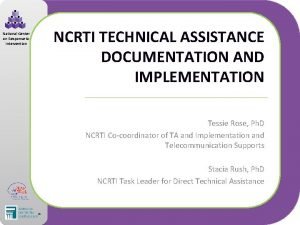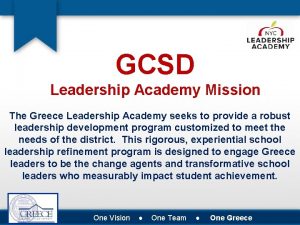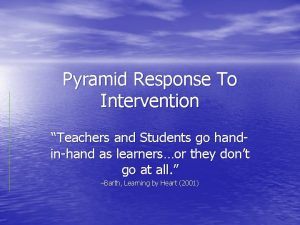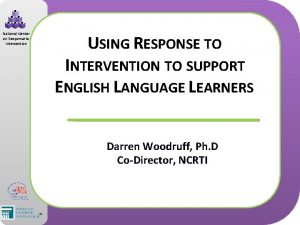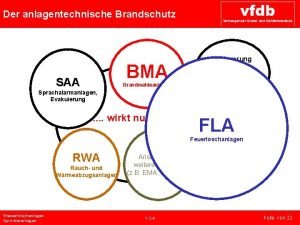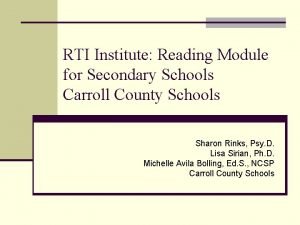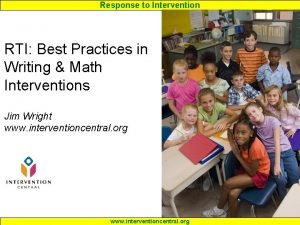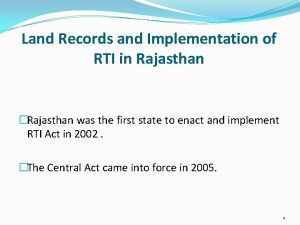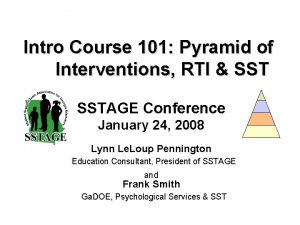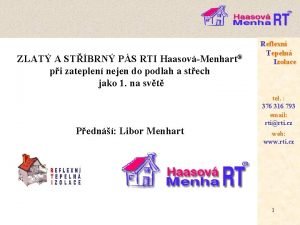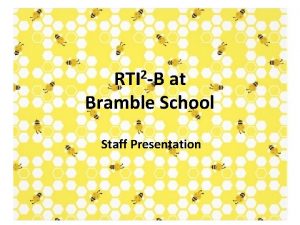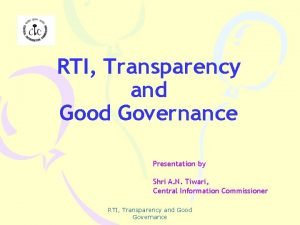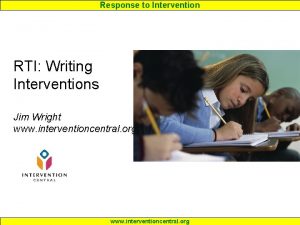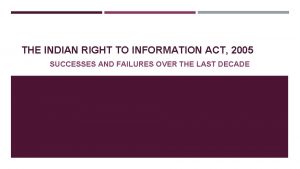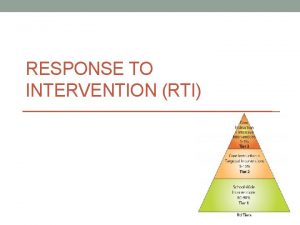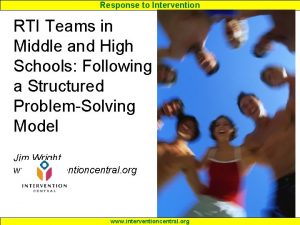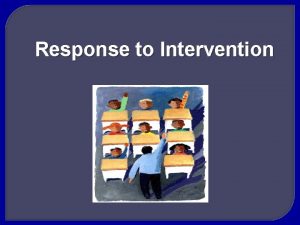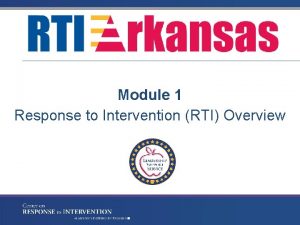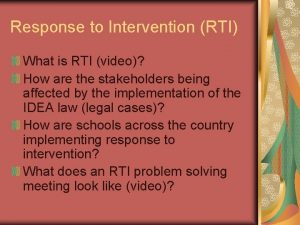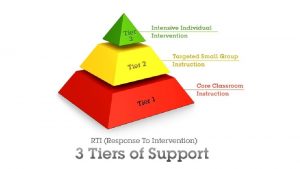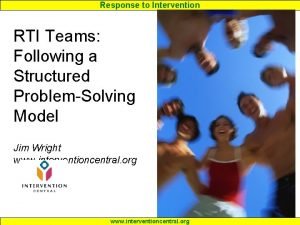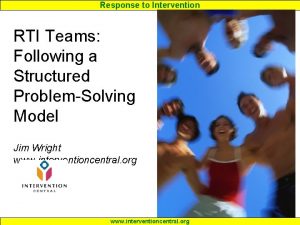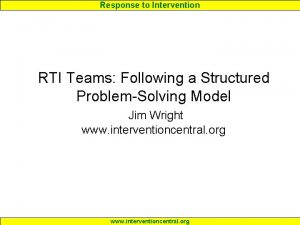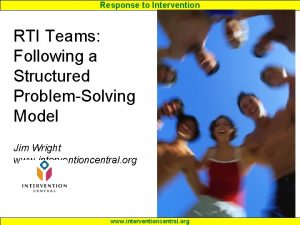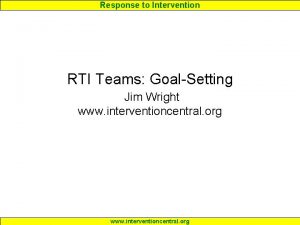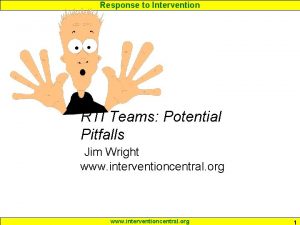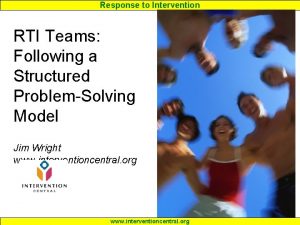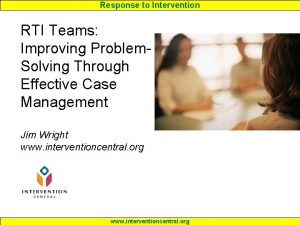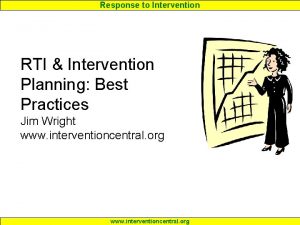Response to Intervention RTI Intervention Teams in Middle

















- Slides: 17

Response to Intervention RTI Intervention Teams in Middle & High Schools: Challenges and Opportunities Jim Wright www. interventioncentral. org

Response to Intervention RTI ‘Pyramid of Interventions’ Tier 3 Tier 2 Tier 1 Tier 3: Intensive interventions. Students who are ‘non-responders’ to Tiers I & II may be eligible for special education services, intensive interventions. Tier 2: Individualized interventions. Subset of students receive interventions targeting specific needs. Tier 1: Universal interventions. Available to all students in a classroom or school. Can consist of wholegroup or individual strategies www. interventioncentral. org

Response to Intervention Tier 3: Intensive Individualized Interventions Tier 3 interventions are the most intensive offered in a school setting. Students qualify for Tier 3 interventions because: – they are found to have a large skill gap when compared to their class or grade peers; and/or – They did not respond to interventions provided previously at Tiers 1 & 2. Tier 3 interventions are provided daily for sessions of 30 minutes. The student-teacher ratio is flexible but should allow the student to receive intensive, individualized instruction. Source: Burns, M. K. , & Gibbons, K. A. (2008). Implementing response-to-intervention in elementary and secondary schools. Routledge: New York. The reading progress of students in Tier 3 interventions is www. interventioncentral. org monitored at least weekly.

Response to Intervention Secondary Level: Classroom Performance Rating Form www. interventioncentral. org

Response to Intervention Tier 3 Interventions Are Developed With Assistance from the School’s RTI (Problem-Solving) Team Effective RTI Teams: • Are multi-disciplinary and include classroom teachers among their members • Follow a structured ‘problem-solving’ model • Use data to analyze the academic problem and match the student to effective, evidence-based interventions • Develop a detailed research-based intervention plan to help staff with implementation • Check up on the teacher’s success in carrying out the intervention (‘intervention integrity’) www. interventioncentral. org

Response to Intervention The Problem-Solving Model & Multi-Disciplinary Teams A school consultative process (‘the problem-solving model’) with roots in applied behavior analysis was developed (e. g. , Bergan, 1995) that includes 4 steps: – Problem Identification – Problem Analysis – Plan Implementation – Problem Evaluation Originally designed for individual consultation with teachers, the problem-solving model was later adapted in various forms to multi-disciplinary team settings. Source: Bergan, J. R. (1995). Evolution of a problem-solving model of consultation. Journal of Educational and Psychological Consultation, 6(2), 111 -123. www. interventioncentral. org

Response to Intervention RTI Problem-Solving Teams at the Secondary Level: The Necessary Art of ‘Satisficing’ “The word satisfice was coined by Herbert Simon as a portmanteau of "satisfy" and "suffice". Simon pointed out that human beings lack the cognitive resources to maximize: we usually do not know the relevant probabilities of outcomes, we can rarely evaluate all outcomes with sufficient precision, and our memories are weak and unreliable. A more realistic approach to rationality takes into account these limitations: This is called bounded rationality. ” (Satisficing, Source: Satisficing (2008). Wikipedia. Retrieved on July 2, 2008, from http: //en. wikipedia. org/wiki/Satisficing 2008) www. interventioncentral. org

Response to Intervention How Is a Secondary RTI Team Like a MASH Unit? • The RTI Team must deal with complex situations with limited resources and tight timelines, often being forced to select from among numerous ‘intervention targets’ (e. g. , attendance, motivation, basic skill deficits, higher-level deficits in cognitive strategies) when working with struggling students. • The ‘problem-solving’ approach is flexible, allowing the RTI Team quickly to sift through a complex student case to identify and address the most important ‘blockers’ to academic success. • Timelines for success are often short-term (e. g. , to get the student to pass a course or a state test), www. interventioncentral. org measured in weeks or months.

Response to Intervention Teachers may be reluctant to refer students to the RTI Team because they… • believe referring to the RTI Team is a sign of failure • do not think that your team has any ideas that they haven’t already tried • believe that an RTI Team referral will mean a lot more work for them (vs. referring directly to Special Education) • don’t want to ‘waste time’ on kids with poor motivation or behavior problems when ‘more deserving’ learners go unnoticed and unrewarded • don’t want to put effort into learning a new initiative that www. interventioncentral. org

Response to Intervention Teachers may be motivated to refer students to the RTI Team because they… • can engage in collegial conversations about better ways to help struggling learners • learn instructional and behavior-management strategies that they can use with similar students in the future • increase their teaching time • are able to access more intervention resources and supports in the building than if they work alone • feel less isolated when dealing with challenging kids • have help in documenting their intervention efforts www. interventioncentral. org

Response to Intervention Writing Quality ‘Problem Identification’ Statements www. interventioncentral. org

Response to Intervention Writing Quality ‘Problem Identification’ Statements • A frequent problem at RTI Team meetings is that teacher referral concerns are written in vague terms. If the referral concern is not written in explicit, observable, measurable terms, it will be very difficult to write clear goals for improvement or select appropriate interventions. • Use this ‘test’ for evaluating the quality of a problem-identification (‘teacher-concern’) statement: Can a third party enter a classroom with the problem definition in www. interventioncentral. org

Response to Intervention Writing Quality ‘Problem-Identification’ Statements: Template Format for Writing RTI Team Teacher Concerns Conditions when the behavior is observed or absent Description of behavior in concrete, measurable, observable terms During large-group instruction The student calls out comments that do not relate to the content being taught. When reading aloud The student decodes at a rate much slower than classmates. When sent from the classroom The student often wanders the with a pass to perform an building instead of returning errand or take a bathroom promptly to class. www. interventioncentral. org

Response to Intervention Writing Quality ‘Teacher Referral Concern’ Statements: Examples • Needs Work: The student is disruptive. • Better: During independent seatwork , the student is out of her seat frequently and talking with other students. • Needs Work: The student doesn’t do his math. • Better: When math homework is assigned, the student turns in math homework only about 20 percent of the time. Assignments turned in are often not fully completed. www. interventioncentral. org

Response to Intervention Secondary RTI Teams: Recommendations • Secondary RTI Teams should be multidisciplinary, to include teachers, administration, and support staff (e. g. , school psychologist, guidance counselors). • Fixed times should be set aside each week for the RTI Team to meet on student referrals. • Sufficient time (i. e. , 30 minutes) should be reserved for initial student referrals to allow adequate discussion and intervention www. interventioncentral. org

Response to Intervention Secondary RTI Teams: Combining Consistency & Flexibility • Schools should ensure that RTI Teams follow a structured problem-solving model. • Schools do have flexibility in when and where they use the RTI problem-solving model. For example: – If a person (e. g. , school psychologist, school administrator) is trained to facilitate an RTI Team meeting, that meeting can be scheduled during shared teacher planning times or during parent-teacher conferences. www. interventioncentral. org

Response to Intervention Small-Group Activity: Rate Your RTI Problem. Solving Team • Discuss the problem-solving team that your middle or high school uses to create individualized RTI intervention plans for students. • What are strengths of your team? • What areas of your team’s functioning that could be targeted for improvement? Effective RTI Teams: • Are multi-disciplinary and include teachers among their members • Follow a structured ‘problemsolving’ model • Use data to analyze the academic problem and match the student to effective, evidence-based interventions • Develop a detailed research-based intervention plan to help staff with implementation • Check up on the teacher’s success in carrying out the intervention www. interventioncentral. org
 Hazardous area response teams
Hazardous area response teams National center on response to intervention
National center on response to intervention Simplifying response to intervention
Simplifying response to intervention Pyramid response to intervention
Pyramid response to intervention National center for response to intervention
National center for response to intervention Sprinkleranlage schema
Sprinkleranlage schema Subsplease.orf
Subsplease.orf Rti interventions list
Rti interventions list Rti portal rajasthan
Rti portal rajasthan Jim wright rti
Jim wright rti Rti interventions examples
Rti interventions examples Rti izolace
Rti izolace Rti 2
Rti 2 Rtiddsgen
Rtiddsgen Transparency of good governance
Transparency of good governance Jim wright intervention central
Jim wright intervention central Rti zeromq
Rti zeromq Rti act 2005 introduction
Rti act 2005 introduction

